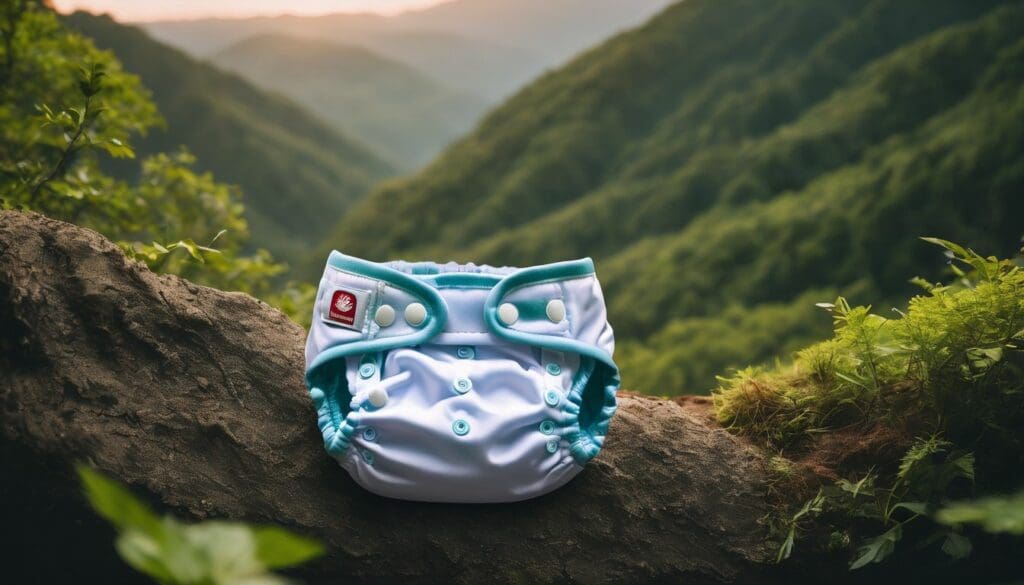As parents, we’re all too familiar with the delicate balancing act between the convenience of disposable nappies and our duty to Mother Earth. It’s a conflict that resonates deeply within many of us, confronting the harsh reality that billions of disposables are destined for landfills around the world each year.
Our blog is lovingly curated with accessible alternatives and savvy solutions aimed at reducing environmental impact whilst ensuring your wee one remains comfortable and happy. Join us as we embark on this journey towards a more sustainable path – it promises to be an enlightening experience for both you and your cherished little ones!
Key Takeaways
- Disposable nappies cause significant environmental damage through landfill pollution, groundwater contamination, and greenhouse gas emissions due to their non-biodegradable plastics and long decomposition times.
- Harmful chemicals used in disposable nappies, like dioxins and phthalates, can negatively affect human health and contribute to ozone depletion.
- Eco – friendly alternatives such as biodegradable disposable nappies or reusable cloth nappies can reduce environmental impact while providing safer options for babies.
- Encouraging the adoption of proper waste management practices and recycling can help mitigate the negative effects of disposable nappy waste on our planet.
- Supporting eco – friendly nappy brands that prioritise sustainable manufacturing processes is crucial for promoting a healthier environment for current and future generations.
The Environmental Impact of Disposable Diapers
Disposable nappies have a significant environmental impact, contributing to transportation emissions, non-recyclable plastic usage, and harmful chemical compounds. They also lead to landfill pollution and groundwater contamination, with long decomposition times and ozone depletion.
Transportation emissions
As we consider the broad environmental impact of disposable diapers, we can’t ignore transportation emissions. Each year, countless trucks hit the roads to deliver these products from factories to stores and eventually to homes across the country.
This constant movement burns fossil fuels, releasing carbon dioxide into our atmosphere and contributing significantly to climate change.
Manufacturing processes also rely heavily on non-recyclable plastics which add further strain on our environment. Moving onto this next point, it’s critical that we understand how single-use plastics within diaper design not only demand vast resources during production but also leave a lasting footprint long after their short service life has ended.
Non-recyclable plastic usage
Disposable diapers contribute significantly to environmental pollution due to their non-recyclable plastic usage. This non-biodegradable plastic takes hundreds of years to decompose, piling up in landfills and releasing harmful chemicals into the soil and water.
The manufacturing process also consumes large amounts of energy and contributes to greenhouse gas emissions, further exacerbating the environmental impact. As environmentally conscious individuals, it’s crucial to consider sustainable alternatives such as biodegradable or reusable diaper options for a healthier planet.
Moving forward, let’s explore the detrimental effects of petroleum-based materials contained in disposable diapers and their implications for both the environment and human health.
Petroleum-based materials
Petroleum-based materials are commonly used in the production of disposable nappies, contributing to environmental concerns. The extraction and refinement of petroleum for nappy manufacturing release greenhouse gases, depleting the ozone layer.
Additionally, the non-renewable nature of these materials adds to landfill pollution and poses long-term groundwater contamination risks. Nappy waste containing petroleum-based products takes a significant time to decompose, further exacerbating environmental impact.
By using alternative options such as biodegradable or reusable cloth nappies, environmentally conscious individuals can significantly reduce their contribution to the negative effects associated with petroleum-based nappy materials.
Harmful chemicals
After discussing the environmental impact of petroleum-based materials used in disposable diapers, it’s important to address the issue of harmful chemicals present in these products.
Diapers often contain dioxins, phthalates, and volatile organic compounds (VOCs) which can be detrimental to both the environment and human health. These chemicals not only contribute to air and water pollution during manufacturing but also pose risks when they come into contact with a baby’s skin.
Exposure to such compounds has been linked to respiratory issues, hormonal disruptions, and allergic reactions.
Landfill pollution
Disposable diapers contribute significantly to landfill pollution due to their non-biodegradable nature. They take an estimated 500 years to decompose, releasing harmful chemicals into the soil and groundwater as they break down.
This long decomposition time means that every disposable diaper ever used is still lingering in a landfill somewhere. Additionally, the plastic components of disposable diapers are not recyclable, further adding to the growing waste problem in landfills.
The buildup of soiled diapers in landfills results in the production of methane, a potent greenhouse gas that contributes to climate change.
Greenhouse gas emission
Disposable diapers contribute to greenhouse gas emissions throughout their lifecycle, including the production of raw materials, transportation, and waste disposal. The manufacturing process involves the release of carbon dioxide and other gases that trap heat in the atmosphere.
Additionally, when disposed of in landfills, these diapers decompose anaerobically, releasing methane—a potent greenhouse gas that contributes to climate change. It’s essential for environmentally conscious individuals to consider sustainable diaper options such as biodegradable or reusable alternatives to reduce the overall impact on greenhouse gas emissions.
Moving forward into “Groundwater Contamination,” it’s imperative to understand how disposable diapers affect this vital natural resource and explore potential solutions for a more sustainable future.
Groundwater contamination
Disposable nappies contribute to groundwater contamination through the leaching of harmful chemicals and toxins into the soil. The materials used in disposable nappies, such as plastics and absorbent gels, can release potentially hazardous substances when they break down in landfills.
As a result, these contaminants can seep into the ground and pollute nearby water sources, posing a risk to both human health and the environment. Biodegradable or reusable nappy options offer a more eco-friendly choice that can help mitigate this issue by reducing the introduction of harmful substances into groundwater.
Moreover, promoting proper waste management practices ensures that nappy disposal does not further contribute to groundwater contamination. Encouraging the use of biodegradable options and raising awareness about their environmental benefits is essential for safeguarding our water sources from potential pollutants associated with traditional disposable nappies.
Long decomposition time
Groundwater contamination poses significant risks to the environment, but another concerning factor is the long decomposition time of disposable diapers. These single-use products can take up to 500 years to decompose in landfills, contributing to a lasting burden on our planet.
This accumulation of diaper waste exacerbates landfill pollution and greenhouse gas emissions, highlighting the pressing need for eco-friendly alternatives like biodegradable or reusable diaper options that can significantly reduce their environmental impact.
The Environmental Impact of Disposable Diapers: Alternatives and Solutions
Ozone depletion
After considering the long decomposition time of disposable nappies, it’s essential to address their contribution to ozone depletion. The production and disposal of petroleum-based materials in these nappies release harmful chemicals such as chlorofluorocarbons (CFCs) into the atmosphere, which directly contribute to the depletion of the ozone layer.
This results in increased exposure to ultraviolet rays from the sun, posing risks for human health and ecosystems alike.
To mitigate this issue, it’s crucial for environmentally conscious individuals to understand how their choice of nappies can impact ozone depletion and opt for eco-friendly alternatives like biodegradable or reusable options that are free from harmful substances.
Use of carcinogens in manufacturing
Manufacturers often use carcinogenic substances in the production of disposable nappies, posing a risk to both the environment and human health. The presence of these harmful chemicals in the manufacturing process contributes to pollution during nappy production, with emissions impacting air and water quality.
This practice underlines the importance of seeking eco-friendly alternatives like biodegradable or reusable nappies that minimise exposure to carcinogens, promoting a healthier choice for our planet and families.
Opting for environmentally sustainable options such as biodegradable or reusable nappies reduces reliance on manufacturing processes that employ carcinogenic materials. By choosing eco-friendly nappy solutions, we actively contribute to reducing environmental pollution while safeguarding our well-being from potentially hazardous substances found in conventional disposable choices.
Effects of Disposable Diapers on Human Health
Disposable diapers contain chemical compounds that can lead to skin irritation and allergic reactions in babies, potentially causing long-term health issues. To learn more about the impact of disposable diapers on human health and explore alternative solutions, continue reading our blog.
Convenience vs waste
Using disposable diapers is convenient, but it leads to a significant amount of waste. Convenience comes with a cost – the environmental impact of diaper waste can be detrimental. The excessive use of disposable diapers contributes to landfill pollution and greenhouse gas emissions.
It’s important to weigh convenience against the long-term effects on the environment when choosing diaper options.
Consider eco-friendly choices that reduce waste and promote sustainability in your parenting journey.
Chemical compounds in diapers
Diapers contain various chemical compounds, including dioxins, phthalates, and volatile organic compounds. These substances can pose health risks to babies and the environment. Dioxins are known carcinogens and may affect reproductive and immune systems.
Phthalates are linked to hormone disruption, while volatile organic compounds can contribute to air pollution. By understanding these chemical components in diapers, parents can make informed choices for their baby’s health and environmental impact.
Manufacturers use chemicals in disposable diapers for absorption, scent control, and waterproofing. However, these chemical compounds can have long-term effects on both human health and the environment.
Alternatives to Disposable Diapers
Consider using biodegradable disposable diapers or reusable cloth diapers as more eco-friendly alternatives to traditional disposable diapers. To learn more about the environmental impact of diaper choices and how you can make a difference, continue reading our blog.
Biodegradable disposable diapers
Biodegradable disposable nappies offer an eco-friendly alternative to traditional disposable nappies. Made from plant-based materials such as bamboo or cornstarch, they decompose more quickly than conventional nappies, reducing landfill waste and environmental pollution.
These environmentally sustainable options are free from harmful chemicals, promoting a healthier choice for babies and the planet. Additionally, selecting biodegradable disposable nappies can contribute to sustainable living practices by supporting waste reduction and recycling initiatives while embracing zero waste parenting.
Switching to biodegradable nappies supports green parenting choices and reduces the carbon footprint associated with traditional nappy use. By choosing these eco-friendly nappies, parents can actively participate in environmental conservation efforts and positively impact the future of our planet.
Reusable cloth diapers
Reusable cloth nappies are an eco-friendly alternative to disposable options. They help reduce nappy waste and minimise the environmental impact of nappy use. Cloth nappies can be washed and reused, which not only saves money but also decreases the amount of non-recyclable plastic ending up in landfills.
Using reusable nappies also promotes sustainability by cutting down on petroleum-based materials and reducing greenhouse gas emissions associated with manufacturing and disposal. By choosing cloth over disposable nappies, individuals can make a positive impact on the environment while providing their baby with a comfortable and safe option.
Solutions to Reduce the Environmental Impact
Encouraging the use of biodegradable and reusable options, promoting proper waste management and recycling, and advocating for eco-friendly diaper brands are some key solutions to mitigate the environmental impact of disposable diapers.
Discover more about how you can make a positive difference in reducing diaper waste by reading the full blog post.
Encouraging use of biodegradable and reusable options
We can reduce the environmental impact of disposable nappies by encouraging the use of biodegradable and reusable options. Choosing biodegradable disposable nappies made from recycled materials or reusable cloth nappies helps to minimize nappy waste going into landfills, reducing the harmful effects on the environment.
By promoting eco-friendly nappy brands and educating others about the benefits of using biodegradable and reusable options, we can contribute to a more sustainable future for our planet.
Opting for biodegradable and reusable options significantly reduces greenhouse gas emissions, ozone depletion, and groundwater contamination associated with traditional disposable nappies.
Proper waste management and recycling
Proper waste management and recycling play a crucial role in reducing the environmental impact of nappy disposal. By separating nappies from regular waste, we can facilitate their proper treatment or recycling.
Encouraging the use of biodegradable and reusable options alongside promoting eco-friendly nappy brands can significantly minimise the negative effects of disposable nappy waste on our environment.
To achieve this, raising awareness about responsible nappy disposal and supporting initiatives for efficient recycling programmes is essential. Engaging in sustainable practices like composting or exploring innovative recycling technologies will contribute to mitigating the environmental consequences associated with disposable nappies while also protecting human health and conserving natural resources.
Promoting eco-friendly diaper brands
To reduce the environmental impact of nappy usage, we actively promote eco-friendly nappy brands. By opting for biodegradable and reusable options, individuals can make a significant contribution to waste reduction.
Encouraging the use of environmentally friendly nappies not only minimises landfill pollution but also supports sustainable manufacturing practices, promoting healthier living environments for current and future generations.
Encouraging the use of eco-friendly nappies is essential in minimising the negative effects of disposable alternatives. By supporting these initiatives, we play a vital role in preserving our environment for future prosperity.
Conclusion
In conclusion, choosing eco-friendly nappy options can significantly reduce the environmental impact of nappy usage. Encouraging the use of biodegradable and reusable alternatives will help minimise landfill pollution and greenhouse gas emissions caused by disposable nappies.
Proper waste management and recycling initiatives play a vital role in reducing the negative effects of nappy waste on the environment. Promoting awareness about eco-friendly nappy brands is essential to ensure responsible nappy choices for a sustainable future.
FAQs
1. What is the environmental impact of disposable nappies?
Disposable nappies contribute to ozone depletion and can have a negative effect on our environment because they create nappy waste that’s hard to recycle.
2. Why are eco-friendly nappy solutions important?
Eco-friendly nappy solutions help reduce the environmental impact of nappies by offering alternatives like cloth nappying which don’t harm nature as much.
3. How does choosing eco-friendly nappies make a difference?
Choosing eco-friendly nappies helps manage nappy waste better, reducing the harmful consequences disposables have on our planet.
4. Can we assess how these different types of nappies affect the earth?
Yes, an environmental impact assessment can show us just how each type of nappy choice affects our environment, guiding us toward greener options.





